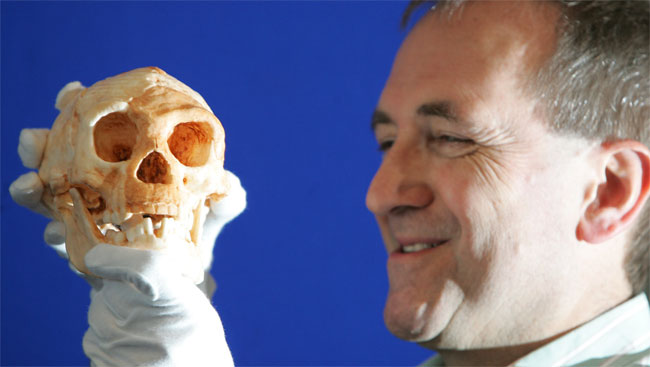Jawbone Added to 'Hobbit' Evidence

Scientists digging in a remote Indonesian cave have uncovered a jaw bone that they say adds more evidence that a tiny prehistoric Hobbit-like species once existed.
The jaw is from the ninth individual believed to have lived as recently as 12,000 years ago. The bones are in a wet cave on the island of Flores in the eastern limb of the Indonesian archipelago, near Australia.
The research team which reported the original sensational finding nearly a year ago strongly believes that the skeletons belong to a separate species of early human that shared Earth with modern humans far more recently than anyone thought.
The bones have enchanted many anthropologists who have come to accept the interpretation of these diminutive skeletons marooned on Flores with dwarf elephants and other miniaturized animals, giving the discovery a kind of fairy tale quality.
But a vocal scientific minority insists the specimens are nothing more than the bones of modern humans that suffered from microencephaly, a broadly defined genetic disorder that results in small brain size. The latest discovery on Flores to be published in Thursday's issue of the journal Nature does not change their minds, they said, with one critic describing the latest artifacts as "pretty scrappy.''
And, at least two groups of opponents have submitted their own studies to other leading scientific journals refuting the Flores work.
The result is a controversy unlike any other in the often-contentious study of human origins. Those caught in the middle say the debate is a real test for what we know about human evolution.
Sign up for the Live Science daily newsletter now
Get the world’s most fascinating discoveries delivered straight to your inbox.
Daniel E. Lieberman of the Peabody Museum at Harvard said the specimens are so unusual that they deserve a more detailed analysis in order to adequately answer the critics.
"Many syndromes can cause microencephaly and dwarfism and they all need to be considered,'' said Lieberman, who wrote a commentary in Nature. "The findings are not only astonishing, but also exciting because of the questions they raise.''
In the latest Nature study, the same team of Australian and Indonesian scientists working in trenches dug in Liang Bua cave found a variety of additional bones at various depths, suggesting the cave had been occupied for tens of thousands of years by several generations.
The most prominent specimen discovered in the latest batch is the lower jaw bone from a separate individual. Dating of charcoal nearby in the excavation layer suggests it is 15,000 years old.
They also found the right arm of the 18,000-year old female announced last year, as well as fragments of other skeletons.
The jaw reported now has a weaker chin with smaller tooth dimensions than last year's primary specimen, but otherwise shares the same characteristics.
Other artifacts in the cave include cut and charred bones of stegodon, a prehistoric pygmy elephant, and other animals, as well as a variety of sophisticated stone tools. The researchers said the artifacts offer further proof that the cave's tiny inhabitants were capable of advanced thinking and behavior, like cooperative hunting.
Critics say they have many lingering questions about the Flores discoveries.
"This paper doesn't clinch it. I feel strongly that people are glossing over the problems with this interpretation,'' said Robert Martin, a biological anthropologist and provost of the Field Museum of Natural History in Chicago.
In Martin's view, the more likely scenario is that the specimens belonged to an extended family of modern humans, some of whom suffered from microencephaly, which often runs in families.
The critics challenge the reliability of the dating of bones and artifacts because only a few pieces of charcoal _ presumably from fire pits _ were analyzed. Also, water drainage may have helped jumble the older specimens with the more recent.
And, they argue, the stone tools found are of the type known to be made only by modern humans. The brain size of the specimens found suggest it's unlikely such a people could have used the tools.
- 'Hobbit' Brain Reconstructed









